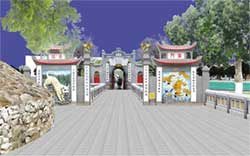On a computer, viewers can simply click a few times to zoom in on the intricate details of Ngọc Sơn Temple – an important historical site in Hanoi, admire the mosaic paintings on the walls, and also zoom out to take in the entire temple grounds.
 |
| Ngọc Sơn Temple (by Hoàn Kiếm Lake) is recreated using virtual reality technology. (Photo: SGGP) |
This is just one example in the project to revive the Thăng Long citadel using virtual reality technology, conducted by a team of IT experts in Hanoi, comprising 12 young individuals. Engineer Nguyễn Văn Trường, from the Simulation Technology Center at the Military Technical Academy, one of the four “core” members of the team, stated: “We have initially developed a program using virtual reality technology to recreate the images of historical sites in Hanoi. Virtual reality technology is currently developing worldwide and has been applied in various fields.”
Every tiny detail, such as furniture, colors, and textures of the structures, is accurately modeled based on historical records. The scenery, lighting, and sounds also change according to the observer’s position…
Mr. Trường mentioned: “The program that our research team is working hard to build will allow viewers to interact with the site in a very vivid way. They will not only receive information about the site but also experience many emotions of “real life in a virtual space.” This is the effect of digital technology, which is very exciting for visitors.”
In many countries in the region such as Japan and Thailand, virtual reality technology has proven highly effective in the preservation and restoration of architectural heritage. However, due to various limitations in historical knowledge, human resources, and funding, this young research team from Vietnam has currently only been able to gather information about the current state of the sites, without comprehensive historical data about their formation and existence.
Nguyễn Minh Đức, another member of the team, recounted that to gain permission to enter the Thăng Long Imperial Citadel for measuring, photographing, and collecting data for the program, they had to work hard to persuade the site management. For the Old Quarter of Hanoi, at times the team had to “go guerrilla,” such as hiding a large ladder at a nearby beer shop and waiting for the “right moment” to measure and study the archway…
“It is very challenging for us due to our lack of deep historical knowledge. We hope to receive cooperation from historians,” Đức said. Additionally, the budget for developing the program is quite expensive, currently amounting to tens of millions of Vietnamese Dong, not to mention the specialized equipment that the team members are still… using borrowed from their workplace.
Phạm Minh Ngọc, another team member, shared: “We are very eager to participate in building a “digital museum” for historical sites in Hanoi specifically and across the country in general. In the near future, if we receive support, by 2010, we will certainly establish a repository of historical sites in Hanoi using virtual reality technology. This is our great desire, also as a small contribution towards the celebration of the 1,000th anniversary of Thăng Long – Hanoi in 2010.”
The research team is currently hoping that relevant authorities at both the central and Hanoi levels will pay attention to review and assess the project, helping them officially “give birth” to the intellectual offspring they have nurtured for many months, also to “digitize” the most important historical and cultural sites of the capital and the country.


















































